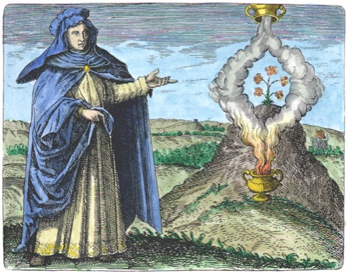Review
Considered one of the founders of alchemy and a significant contributor to practical science, Mary's legacy includes the invention of important laboratory devices such as the tribikos (a three-armed alembic for the distillation process), the kerotakis (used for heating substances), and the bain-marie, one of the oldest laboratory techniques still in use today.
Although her writings did not survive the destruction of the Library of Alexandria, it is believed that she authored several treatises on alchemy. Her teachings were cited by Zosimos of Panopolis (4th century) and other later scholars, underscoring the enduring significance of her contributions.
Justifications
- Chemist, alchemist, and inventor.
- A significant contributor to practical and empirical science.
- She introduced glass into the chemistry laboratory.
- She invented the "bain-marie" (Mary's bath) or indirect heat method and the "black Mary," used to waterproof walls. Both contributions remain in use 1,800 years later.
- She invented the kerotakis, the first hermetically sealed device in the history of science, a precursor to the apparatus currently used to produce graphene.
- One of the great scientists of antiquity, a must-see.
Biography
Also known as Mary the Jewess or Mary the Prophetess, she was one of the founders and key figures in the birth of alchemy, the precursor to modern chemistry. As the creator of laboratory procedures and equipment, her inventions were used for millennia and remain in use today, including the famous "bain-marie."
Her historical figure remains shrouded in obscurity, yet she is an indispensable scientist for understanding the development of science in antiquity. It is believed she lived in Alexandria between the 1st and 3rd centuries CE. Although her original writings have not survived, they are preserved in citations and fragments included in later works. Among her contributions are the "bain-marie," distillation instruments such as the tribikos—a primitive form of alembic—and the kerotakis, the most important apparatus she created. The kerotakis was the first hermetically sealed device and has undergone constant development and improvement since then, remaining in use to this day. It is a reflux apparatus used to analyze and purify metals as well as to extract essential oils from plants, such as roses. This device was utilized throughout Antiquity, the Middle Ages, and even into the Renaissance. In the 19th century, it was modified by the German scientist Franz von Soxhlet, leading to the creation of the Soxhlet extractor. In the 20th century, it inspired the apparatus used to fabricate ultrathin layers of graphene. Its longevity is immense, though inversely proportional to the recognition Mary has received.
Using this type of laboratory equipment, Mary was able to create substances like the "black mary," a mixture of lead and copper sulfides used as a pigment in painting and as a wall waterproofing agent. Its use persisted until the 20th century. She is credited with introducing glassware into the chemistry laboratory, marking the beginning of the use of glass instruments in scientific experimentation. Another of Mary's fundamental contributions was her significant advancement of empirical science. She inaugurated empirical alchemy, a movement that lasted only 300 years but profoundly influenced the development of experimental scientific traditions.
Mary’s numerous contributions, including the bain-marie, the black mary, the use of glass in laboratories, instruments like the tribikos, and especially the kerotakis, along with her dedication to empirical verification—an approach that took centuries to be revived—place her among the greatest scientists of antiquity and an indispensable figure in the history of science. For these reasons, she was regarded as one of the great masters of chemistry and alchemy.
She is cited by Zosimos of Panopolis (4th century), by an 8th-century Byzantine chronicler, and by the 9th-century Arab scholar Al-Nadim.
Works
She is known to have written several texts on alchemy, but none of them seems to have survived. Among those cited are
Extracts by a Christian philosopher, also known as Dialogue of Mary and Aros.
It seems to have been burned in a fire in the Library of Alexandria and has not reappeared. We know these works because they are quoted by several authors - and some authors - from different periods.
creation of the densimeter, the kerotakis and the tribikos
Didactic approach
It can be worked on in:
Physics and Chemistry, when starting the chemistry laboratory, with chemical changes or formulations, among other topics.
Technology, with her proposals such as the kerotakis or the black mary to waterproof walls, the tribikos for distillation, or the use of glass in the laboratory.
Biology, with plant extraction or waterproofing houses.
Geography and History, when addressing scientific development in antiquity.
Classical Culture, with the cultural importance of Alexandria at that time, presenting Mary as one of the examples.
Guidance, using the figure of Mary of Alexandria as a role model of a woman in science to show science as a female domain since antiquity and help close the gender digital divide.
Documents
